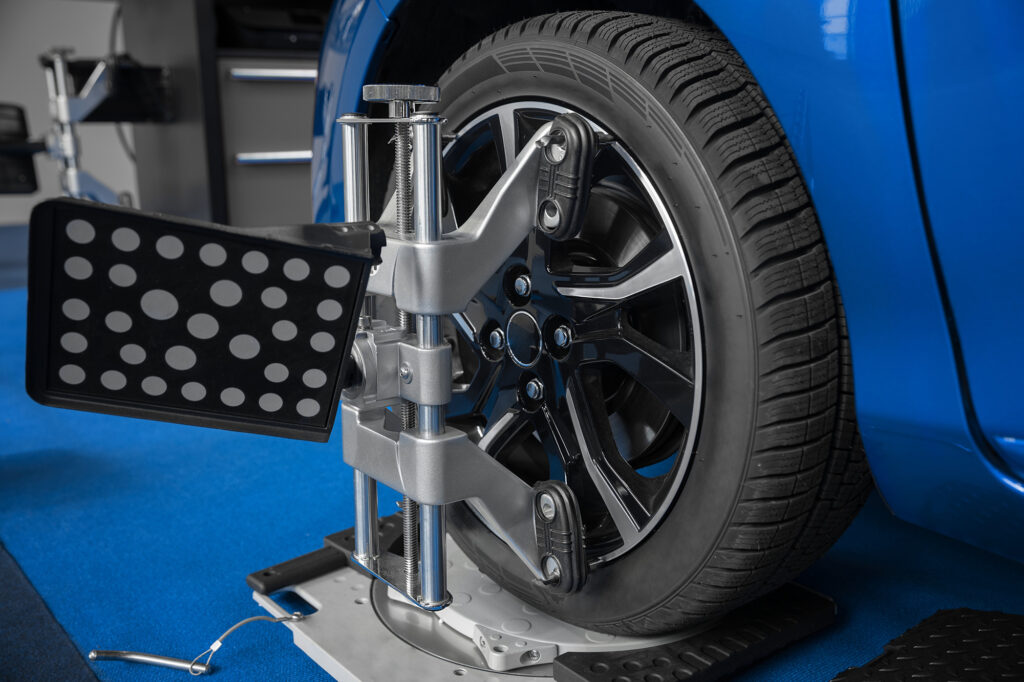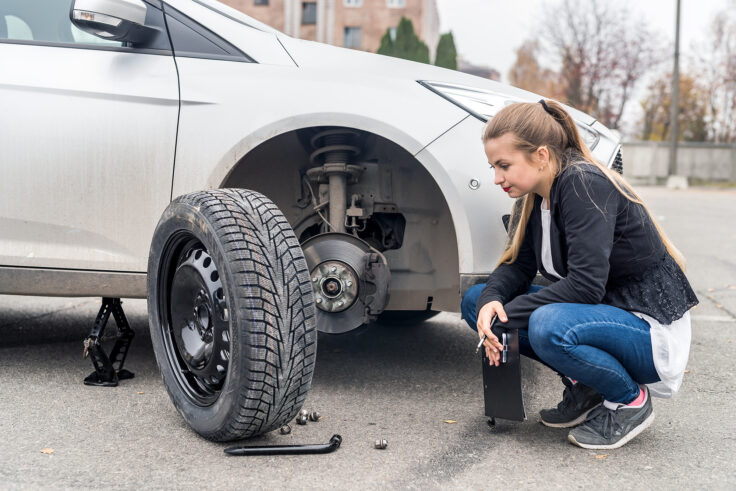Replacing your tires feels like a step in the right direction, but there’s more to it. Your brand-new tires may not last long if your wheels aren’t aligned properly. A wheel alignment adjusts the angles of your tires to help ensure they meet the road at the correct angle, allowing them to wear evenly and perform at their best. Without this crucial step, you could face uneven wear, reduced performance and a bumpy ride — literally. So, do you need a wheel alignment after replacing the tires? The short answer is yes. Let’s break down why it’s so important and how it benefits your vehicle.
Why Wheel Alignment is Important After Replacing Tires
Maximize Tire Lifespan
Proper alignment helps you get the most out of your new tires. It works by evenly distributing the weight of your vehicle across all four tires, reducing the risk of uneven wear. With the right alignment, you can enjoy a longer-lasting set of tires, saving you money and keeping your car running smoothly.
Improve Vehicle Performance
A proper alignment does more than just keep your tires in line; it can dramatically improve your vehicle’s performance. Here’s how:
- Smoother Steering: Misalignment can make your car pull to one side, making it harder to control. Proper alignment can help your car drive straight, making steering more responsive and reducing the strain on your arms during longer drives.
- Better Fuel Efficiency: When your wheels are out of alignment, your car might have to work harder to move forward. This extra effort can increase fuel consumption. A proper alignment helps reduce rolling resistance, keep your car gliding smoothly and use less fuel, which can save you money at the pump.
- Reduced Tire Wear: Aligned wheels help promote even tire wear, compared to misaligned wheels that can cause uneven wear patterns, forcing you to replace tires more often. A proper alignment maximizes tire lifespan, helping you get the most out of your investment.
- Enhanced Safety: Proper alignment helps your vehicle respond more predictably, giving you better control during turns and stops. This can reduce the risk of losing control and help you avoid potential accidents, especially in unexpected driving situations. A well-aligned vehicle makes it easier to handle sharp turns and sudden stops, giving you a smoother, more controlled driving experience.
- Improved Suspension Performance: Your vehicle’s suspension system works in sync with your tires. Misalignment can put extra stress on suspension components, leading to premature wear. Proper alignment helps your suspension system perform better and last longer.
Prevent Uneven Tire Wear
After you’ve just invested your hard-earned money on a new set of tires, the last thing you want is to see them wear down unevenly. Misalignment can fast-track that problem, meaning you might be back in the shop replacing them sooner than you’d like.
Signs Your Vehicle May Need a Wheel Alignment
Here are some key signs to watch for that may indicate your vehicle needs alignment services:
- Pulling to One Side: If your car drifts to one side while driving straight — whether you’re holding the steering wheel steady or notice it happening without much input it might be a strong indication that your wheels are out of alignment.
- Off-Center Steering Wheel: A crooked steering wheel while driving straight is a common sign of misalignment, especially after new tires are installed. This indicates that the wheels aren’t properly aligned with the car’s frame, which can affect handling and performance.
- Vibrating Steering Wheel: Experiencing a shaking or vibrating steering wheel during your drive is often linked to alignment problems. Misaligned wheels can create uneven pressure on the tires, leading to instability. Correcting the alignment can restore smooth handling and improve your driving comfort.
These alignment issues not only affect your vehicle’s performance but can also lead to premature tire wear and higher repair costs down the road. If you notice any of these signs, it’s best to have your alignment checked by a professional to keep your car running smoothly and efficiently.
What Happens if You Don’t Get an Alignment After Replacing Tires?
Neglecting to get a wheel alignment after replacing tires can lead to a range of issues that affect both your vehicle’s performance and your wallet. Here’s what could happen if alignment is overlooked:
- Uneven Tire Wear: Misaligned wheels can cause your tires to wear unevenly, leading to the need for replacement much sooner than expected. This can cost you more money in the long run.
- Reduced Fuel Efficiency: When your wheels aren’t properly aligned, rolling resistance increases, which can cause your vehicle to work harder to move forward. Over time, this added strain can lead to decreased fuel efficiency and higher fuel costs.
- Handling Issues: Poor alignment can affect how your vehicle responds, making it more difficult to control, particularly when turning or braking. This lack of control may increase the risk of handling issues and contribute to unsafe driving conditions.
Addressing alignment issues early can prevent these problems, keeping your vehicle running efficiently and saving you from costly repairs down the road. Don’t let misalignment compromise your driving experience — getting an alignment after replacing tires is a smart investment in your vehicle’s performance.

What Is the Wheel Alignment Process?
Here is how the professionals handle it:
- Inspection: A professional technician will carefully examine your vehicle’s wheel angles, specifically camber, toe and caster, to check for any misalignment.
- Adjustment: Using advanced equipment, the technician makes precise adjustments to bring your wheels back to the optimal angles for your vehicle. This step helps promote proper alignment for a smoother ride and even tire wear.
- Post-Service Check: Once the alignment is complete, a final inspection is done to confirm that your new tires and the alignment are perfectly synced, helping to ensure the best possible performance for your vehicle.
How Often Should You Get a Wheel Alignment?
After Replacing Tires: It’s a good idea to get an alignment after installing new tires, particularly if your old ones had uneven wear. This helps ensure your new tires wear evenly from the start.
Routine Maintenance: Many experts recommend checking your alignment every 6,000 to 10,000 miles or as part of your regular vehicle maintenance schedule to help keep your car running smoothly and prevent premature tire wear.
Temporary Tire Fixes vs. Permanent Tire Repairs
When it comes to tire repairs, it’s important to understand the difference between temporary fixes and permanent solutions. Here’s a breakdown of your options:
Tire Repair Plug vs. Plug and Patch
- Tire Repair Plug: A tire repair plug is a quick, temporary solution that can be inserted into the puncture to stop air from leaking. It’s great for providing immediate relief when you’re on the road and need to quickly patch up a small puncture. However, a plug alone may not be a long-term fix and is best used to get you to a professional for a more permanent repair.
- Plug and Patch: For a permanent solution, a combination of a plug and patch is recommended. The plug seals the puncture from the inside, while the patch reinforces the tire’s structure, preventing future leaks. This method offers more durability and reliability than a plug alone and can help extend the life of your tire, saving you from a premature replacement.
When To Replace the Tire
Tire damage can sometimes be repaired, but there are cases when a full replacement is the only safe option. Below are some key signs that indicate it’s time to replace your tire rather than attempt a repair:
- Damage to the Sidewall: If a nail or other sharp object punctures the tire near the sidewall, repair is not recommended. The sidewall bears a lot of stress while driving, making it unsafe to patch in this area.
- Large Punctures or Deep Cuts: When a puncture or cut is too large for a repair, replacing the tire is the safest option. A large puncture weakens the tire and can lead to a blowout.
- Significant Tread Wear: If the tire’s tread is worn down too much, even a repaired tire won’t provide enough traction. Replacing the tire will ensure proper grip and safety on the road.
Failing to replace a damaged tire can lead to bigger problems, such as reduced traction, poor handling and even the risk of a blowout. Acting on these signs early helps you avoid these issues, ensuring your vehicle stays safe and performs as it should.
Common Issues With Tires and Alignments
Tire damage and alignment problems are issues that most drivers will face at some point. Knowing how to address them quickly and effectively can help keep your vehicle safe and on the road. Here are two common problems and what you should do about them:
- Running Over a Nail: One of the most common causes of a punctured tire is running over a nail or similar sharp object. This type of damage requires immediate attention to prevent further issues. Depending on the location and severity, you may be able to use a tire repair plug for a temporary fix, but in some cases, a full replacement may be necessary for safety.
- Flat Tire on the Side of the Road: A flat tire can happen unexpectedly, and having a repair kit on hand can provide a temporary solution. However, after a quick fix, it’s important to follow up with a professional alignment and possibly a permanent tire repair to help ensure your vehicle continues to drive safely and smoothly.
Hit the Road With Confidence — Get Your Tires and Alignment Checked Today!
Don’t let a minor issue with your tires or alignment turn into an expensive and potentially dangerous problem. Misalignment can lead to uneven tire wear, reduced fuel efficiency and even compromised handling, putting your safety at risk.
Schedule your tire service with Apex Automotive today to help keep your vehicle running smoothly, avoid premature tire replacement and stay safe on the road.


